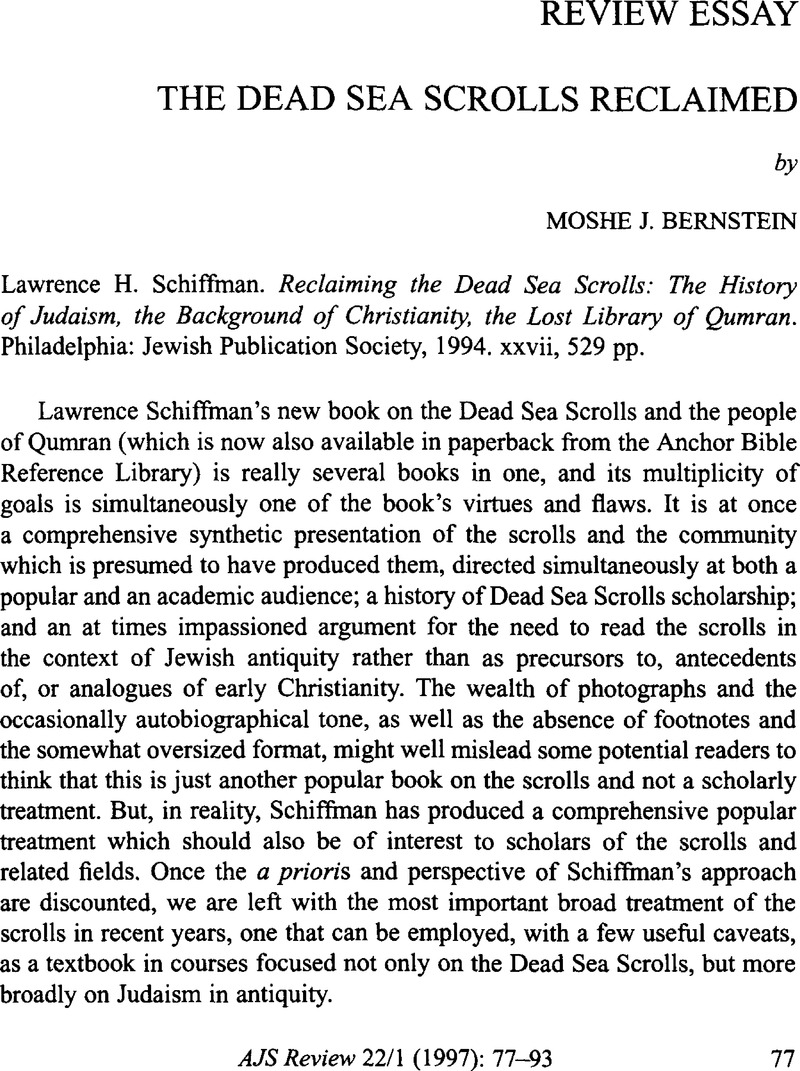No CrossRef data available.
Published online by Cambridge University Press: 15 October 2009

1. Texts from the Judean desert (including, but not limited to, the Qumran scrolls) are identified by a siglum indicating location, in this case Cave 4 from Qumran, and title. E. Qimron and J. Strugnell (in consultation with Y. Sussmann and with contributions by Y. Sussmann and A. Yardeni), Qumran Cave 4, V: Miqat Ma ‘aśe Ha-Torah, Discoveries in the Judaean Desert 10 (Oxford: Clarendon, 1994) is the recently published text of this so-called “halakhic letter,” the delay in whose publication caused a good deal of the stir which resulted in easier access for all scholars to the scrolls in the early 1990s. Surviving in six fragmentary copies from Cave 4, it contains a selection of halakhot wherein the author of MMT disagrees with unnamed opponents, and a section wherein the author exhorts his addressee to adopt his halakhic positions and join forces with him in opposing another, unnamed, group. Just who the author and the unnamed groups are is the subject of much debate among Qumranologists, as are many other unsettled issues regarding this fascinating text. For preliminary observations based on panel discussions at the 1994 annual meetings of the Society of Biblical Literature and the Association for Jewish StudiesGoogle Scholar, see Kampen, J. and Bernstein, M. J., eds., Reading 4QMMT: New Perspectives on Law and History at Qumran (Symposium 2; Atlanta: Scholars Press, 1996).Google Scholar
2. Schiffman exaggerates only a bit when he links the Essene identification of the group to the “Christianization of the Scrolls” (p. 17). The Essene theory does not imply that these are not Jewish documents, and they may very well furnish us with precursors of Jewish elements which Christianity inherited from common Second Temple Judaism or Essenism. The neglect by many scholars of work by Jewish scholars on the scrolls (p. 19) was probably as much an avoidance of Israeli scholarship written in modern Hebrew as of Jewish scholarship. As we all know, that is not a problem limited to the scholarship on the Dead Sea Scrolls.
3. This work, variously known as the “Damascus Document,” “Damascus Covenant,” “Zadokite Document,” and “Zadokite Fragment,” was first published in 1910 from two fragmentary copies discovered by Solomon Schechter in the Cairo Geniza under the title Fragments of a Zadokite Work. Its centrality to the Qumran community was revealed with the discovery of some ten fragmentary copies, representing a more complete text than the medieval ones, in the caves at Qumran.
4. Cf. the discussions in Qimron and Strugnell's edition and in Kampen and Bernstein, Reading 4QMMT. The reader should also be aware that 4QMMT, despite its surviving in fragments from six manuscripts, is still very fragmentary and its restoration debated. Schiffrnan's quotation on p. 85, “they will repent in Israfel] forjever]” should almost certainly be read “they shall return in Isra[el] to the T[orah]” (reconstructing lat[orah] rather than lat[amid]).
5. Serekh Hayahad, usually referred to as the “Community Rule” or the “Manual of Discipline,” is one of the “complete” scrolls discovered initially in Cave 1 in 1947. It contains both theologically instructive material as well as regulations for conduct within a sectarian framework. Several copies of the work, which demonstrate its complex literary development, have been found in Cave 4.
6. Schiffman's material should now be supplemented by Eileen, Schuller's important article “Women in the Dead Sea Scrolls,” in Methods of Investigation of the Dead Sea Scrolls and the Khirbet Qumran Site: Present Realities and Future Prospects, ed. Wise, M. O. et al. (New York: New York Academy of Science, 1994), pp. 115–131Google Scholar, which appeared too late for its results to be included. Also to be added to the bibliography of this section is Cohen, S. J. D., “The Beauty of Flora and the Beauty of Sarai,” Helios 8 (1981): 41–53, a comparison of the description of Sarai's beauty in lQapGen with a Hellenistic analogue.Google Scholar
7. Add to the bibliography and the reference notes on Aramaic targum the valuable Ph.D. thesis by Zuckerman, Bruce E., “The Process of Translation in 1 lQtgJob: A Preliminary Study” (Yale University, 1980).Google Scholar
8. The presence of a “sectarian” calendar at the beginning of one of the manuscripts of 4QMMT is explained by Schiffman, quite plausibly, as the addendum of a copyist who, knowing the significance of the calendar in the sect's disputes with its opponents, added it to the original “letter.”
9. See, most recently, Dead Sea Discoveries 2, no. 2 (June 1995), an issue devoted completely to “Messianism,” especially Abegg, Martin G., “The Messiah at Qumran: Are We Still Seeing Double?” pp. 125–144Google Scholar. For a broader perspective, Collins, cf. J. J., The Scepter and the Star: The Messiahs of the Dead Sea Scrolls and Other Ancient Literature (New York: Doubleday, 1995).Google Scholar
10. Likewise, the “Messianic Apocalypse” (4Q521), which has an unmistakable reference to resurrection, has been “Christianized” by the probably mistaken suggestion that it is the messiah, and not God, who will resurrect the dead. Although Schiffman's tone occasionally becomes strident in disputing such readings, his argument is correct on its merits, that such messianic texts are best read in the context of ancient Judaism and as “the background to Christianity” of his title. Cf. his remarks on p. 404.